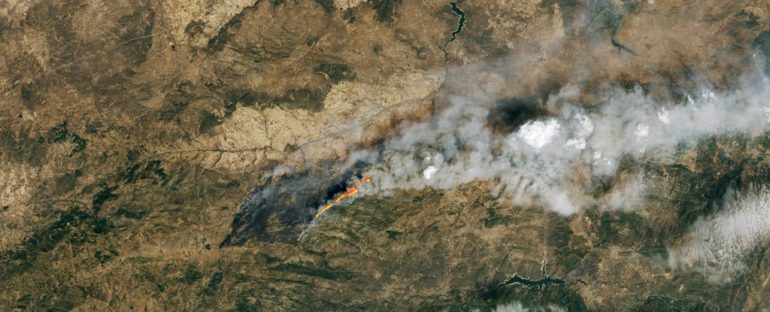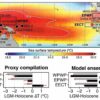For the second year in a row, enormous wildfires are creating clouds of smoke big enough to generate their own weather, blanket entire continents, and turn faraway skies orange or grey.
Smoke is billowing from blazes in the western US, Canada, Greece, Turkey, Italy, Spain, Algeria, and Siberia – so much, in fact, that astronauts on the space station can see it. The wildfires in California and Oregon have darkened skies and led to air-quality warnings in New York City and Boston, as they did last summer.
The Siberian fires, meanwhile, have sent clouds of smoke and ash to the North Pole, nearly 2,000 miles (3,219 km) away, then down to Canada and Greenland.
The Dixie fire smoke seen from the ISS, 4 August 2021. (NASA/JSC)
Each time a big fire burns, its smoke can rise high in the atmosphere, where winds can catch it and carry it for thousands of miles until it hits a weather system that pushes it back towards the ground. That’s when it poses a health risk.
Many people see wildfires as a local problem – a danger to people in Greece or California, say, but not for them personally. That’s incorrect, according to environmental epidemiologist Jesse Berman.
“Every one of these wildfire events is an opportunity for that smoke to travel long distances and affect not only the people nearby, but also those very far away,” Berman told Insider.
“People who live in areas that have relatively good air quality are going to be all of a sudden subjected to levels of pollution that are many times higher than what’s normally seen, and at levels that are very harmful to health.”
These mega-clouds of world-traveling smoke may become a regular, annual occurrence, according to Berman – “if not multiple times every single year,” he said.
Climate change is expected to lead to more frequent, larger, more intense wildfires in the coming decades. A new report from the UN’s Intergovernmental Panel on Climate Change warns that “fire weather” will probably increase through 2050 in North America, Central America, parts of South America, the Mediterranean, southern Africa, north Asia, Australia, and New Zealand.
That means more days where conditions are warm, dry, and windy enough to trigger and sustain wildfires.

The amount of fuel available to burn in those places – dry vegetation – is also likely to increase as rising temperatures cause the air to absorb more moisture and bring about more droughts.
“When these events cover hundreds or thousands of miles, everybody is at risk,” Berman said. “It doesn’t matter where you’re living. You can be affected by these events the same as anyone else.”
Particles in wildfire smoke can strain your lungs, heart, and immune system
Wherever it goes, wildfire smoke fills the air with microscopic particles from the material that has burned and the resulting chemical reactions.
Known as PM2.5, these particles measure no more than 2.5 micrometers across (that’s about 30 times smaller than a human hair), allowing them to penetrate deep into your lungs and enter your bloodstream. When you inhale these particles – as millions of people have in the last year – they can damage the lining of your lungs and cause inflammation.
The Centers for Disease Control and Prevention warns that smoke can “make you more prone to lung infections” including COVID-19, since any breach in the lungs’ lining offers more opportunities for a virus to infiltrate.

Indeed, a recent study linked about 19,000 cases of COVID-19 on the West Coast to wildfire smoke last summer. The paper, published last week, found a correlation between high levels of PM2.5 pollution and spikes in coronavirus cases in counties across California, Oregon, and Washington.
Experts suspected as much. Previous research had already shown that wildfire smoke leaves people more vulnerable to disease. In the short term, smoke can irritate the eyes and lungs and cause wheezing, coughs, or difficulty breathing, even in healthy people.
Longer-term studies have connected PM2.5 pollution to an increased risk of heart attack, stroke, heart failure, and premature death. PM2.5 particles can also impair the immune system, possibly by disabling immune cells in the lungs.
Wildfire smoke can have the most severe effects on people who are already highly vulnerable to COVID-19: the elderly, children (many of whom are unvaccinated against the coronavirus), and people with asthma or chronic lung disease.
This article was originally published by Business Insider.
More from Business Insider:



